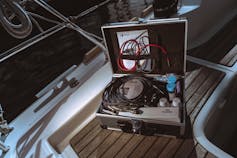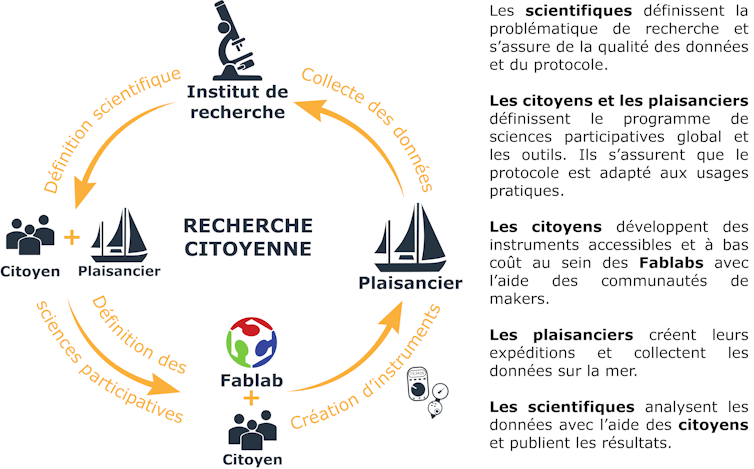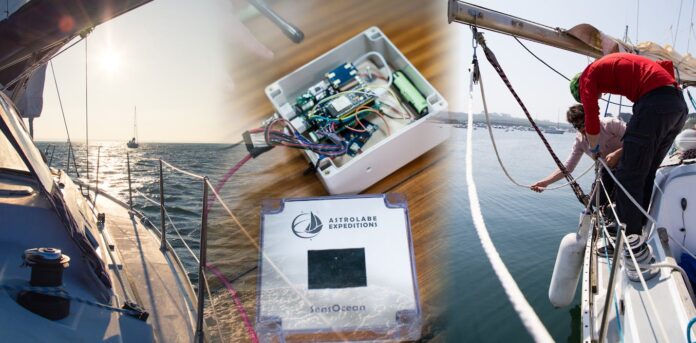Citizen science, which is booming, is valuable for better understanding the oceans and overcoming the limitations of traditional oceanographic research. Some associations, such as Astrolabe Expeditions, equip pleasure sailboats with homemade sensors to create a citizen fleet.
Excitement is at its peak on the pontoons. Magalie has always dreamed of participating in the great maritime scientific odysseys, and today, like James Cook or Jean-François de Lapérouse, she has the pleasure of being able to begin her own scientific expedition at sea. Then Marin and Charlotte arrive on the boat and are proud to present to Magalie and the crew of the sailboat “Altair” the new scientific measurement kit that they have just manufactured in a fab lab in Brest.
This start of an adventure shows that any citizen can participate in scientific research at sea thanks to participatory science. Preserving the environment is not just for scientists: citizens can also play an active role.
Whether on land through construction workshops, or at sea during expeditions, everyone can go out into the field to understand how the ocean works and help preserve it. This is the mission that the association has given itself Astrolabe Expeditionswhich equips sailboats with scientific equipment, trains crews to carry out oceanographic measurements and runs several participatory research programs.
A citizen fleet for oceanographic research
Research at sea is expensive: it involves large ships and complex equipment. Today, the international oceanographic fleet capable of navigating the high seas represents around a hundred boats worldwide. In France, this fleet is operated by Ifremer and is made up of 17 vesselsfour of which sail on the high seas. Campaigns carried out on these ships are not only expensive, but also limited in number due to logistics and the time required for their preparation.
On the other hand, boaters who travel the seas on leisure trips are more than 12,000 each year. In France alone, we have 13 million boaters who sail along the coasts.
Olivier Do Cao — 2019, Provided by the author
There is therefore a unique opportunity, by equipping these sailboats, to create a citizen oceanographic fleet that operates on a large scale. If every pleasure trip can be transformed into a scientific measurement campaign, we can considerably expand research capabilities at sea.
Homemade oceanographic instruments
Yes, but with what instrumentation should these sailboats be equipped? Today, thanks to advances in open source electronics and new technologies, it is possible to develop low-cost instruments for oceanography.
These tools allow citizens to contribute to the collection of data with a precision previously reserved for research institutes. For example, temperature or salinity sensors can now be manufactured at low cost and used by non-specialists.

Mathieu Le Gall, 2022, Provided by the author
All that remains is to make these tools! It is entirely possible to train in welding, 3D printing or even laser cutting in order to design and manufacture the instruments and tools necessary for expeditions. All of this can be done in fab labs, which enable rapid innovation and the creation of instruments that are easy to reproduce in any fab lab around the world.
There is a network of more than 2,000 fab labs around the world, which opens up promising prospects for the large-scale dissemination of these practices which promote collaboration between citizens and scientists.
Participatory science from the sea to your living room
Citizen participation does not necessarily stop at collecting data or constructing instruments. It is also possible to participate in the data analysis carried out by previous expeditions. And this at different levels: we can observe plankton samples under a microscope or identify sargassum with a magnifying glass upon returning from an expedition, but we can also retrospectively, in the warmth of our living room, analyze data from different expeditions.
The APLOSE platform was, for example, a first in France where several dozen citizens were able to analyze cetacean sounds directly to them and produce results that match 80% of the same analysis carried out by scientists.
As a reminder, participatory science were defined in 2016 as forms of scientific knowledge production in which non-scientific actors participate actively and deliberately. Over the past twenty years, participatory science has taken on a growing role, making it possible to collect data for researchers while raising awareness among the general public of marine environmental issues.
These thus encompass a wide diversity of initiatives with different levels of engagement from citizens :
-
With crowdsourcing, citizens collect data, such as observations of marine biodiversity or even physicochemical parameters of the ocean.
-
Distributed intelligence requires more specialized knowledge, with citizens contributing to the interpretation of data, by participating in acoustic recording annotation campaignsFor example.
-
We talk about participatory science when citizens are involved in defining problems and collecting data.
-
Finally, there are complete collaborations where participants are involved in all stages of research, from collection to analysis and valorization of data.
The contribution of marine participatory science
It must be said that participatory research on the ocean is booming. The ocean, which covers more than 70% of the Earth’s surface, plays a central role in the planet’s life cycles. Thanks to the marine current which transports heat from the tropics towards the poles, it is the main climate regulator of our planet. It is responsible for producing more than 50% of the oxygen we breathe (more than tropical forests) and absorbs most of the carbon emitted by living things. It is also a wonderful reservoir of biodiversity which feeds more than half the planet.
Despite this ecological importance and the challenge of better understanding these interactions in the context of climate change, the ocean still remains largely unknown today. There is still much to discover.
To compensate for the lack of human and financial resources allocated to oceanographic research, participatory marine sciences, which can be implemented quickly and on a large scale, appear to be an alternative and complementary practice to traditional research.
This approach has two advantages: not only does it make it possible to collect large quantities of data, but it also raises awareness among a diverse public of issues related to the ocean. Students, naturalists, local elected officials and natural area managers are often invited to participate in these programs.
The Astrolabe Expeditions association thus runs six participatory research programs and suggests that the different actors take different responsibilities depending on the phase of the program and their level of competence.

Astrolabe Expeditions, Provided by the author
Participatory science at sea, supported by associations like Astrolabe Expeditions, opens up new perspectives for research and preservation of the ocean. Whether on land or at sea, you too can invest in the design of protocols, and change society’s relationship with the ocean.
So, are you ready to embark on this scientific and civic adventure?
Written in collaboration with Jody Kimberley Grollier, citizen science program coordinator for Astrolabe Expeditions

This article is published as part of the Science Festival (which takes place from October 4 to 14, 2024), and of which The Conversation France is a partner. This new edition focuses on the theme “ocean of knowledge”. Find all the events in your region on the site Fetedelascience.fr.

